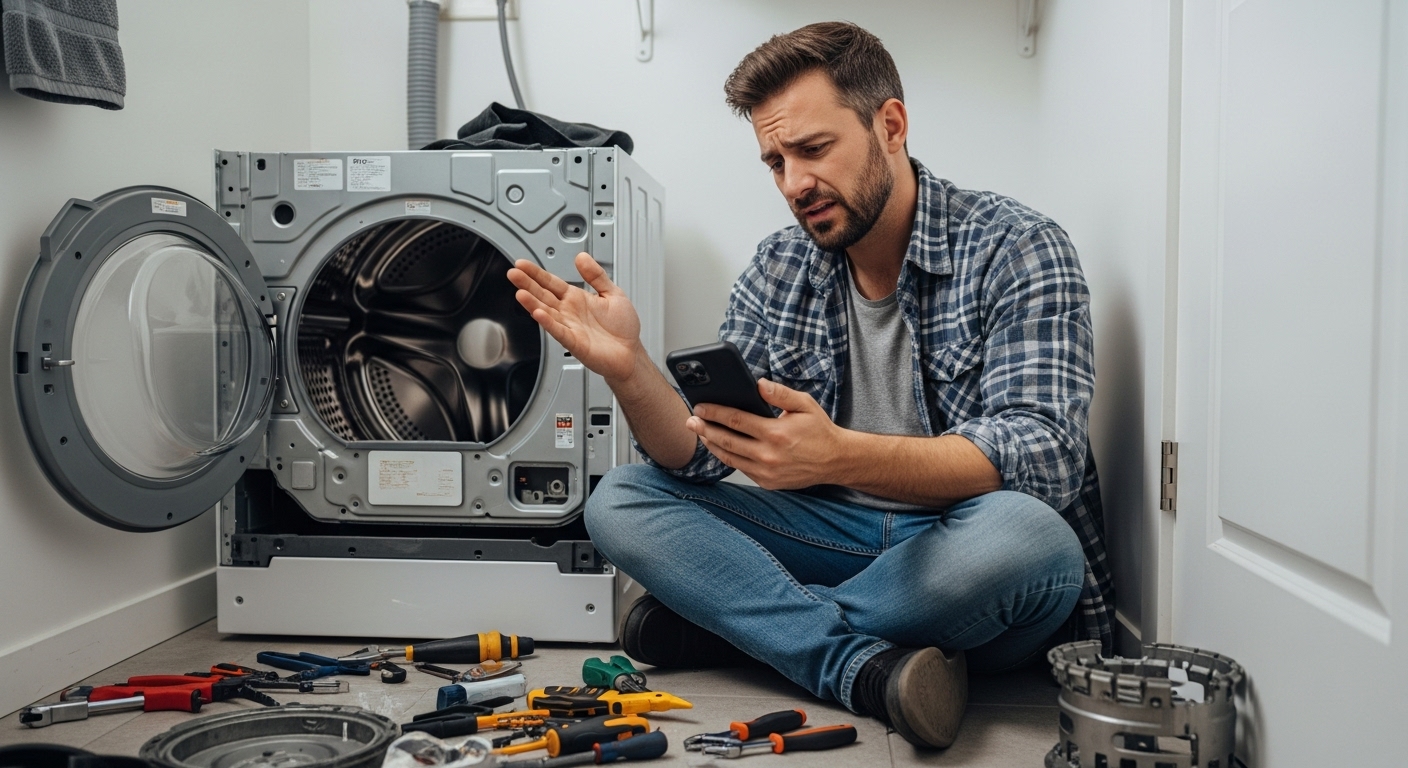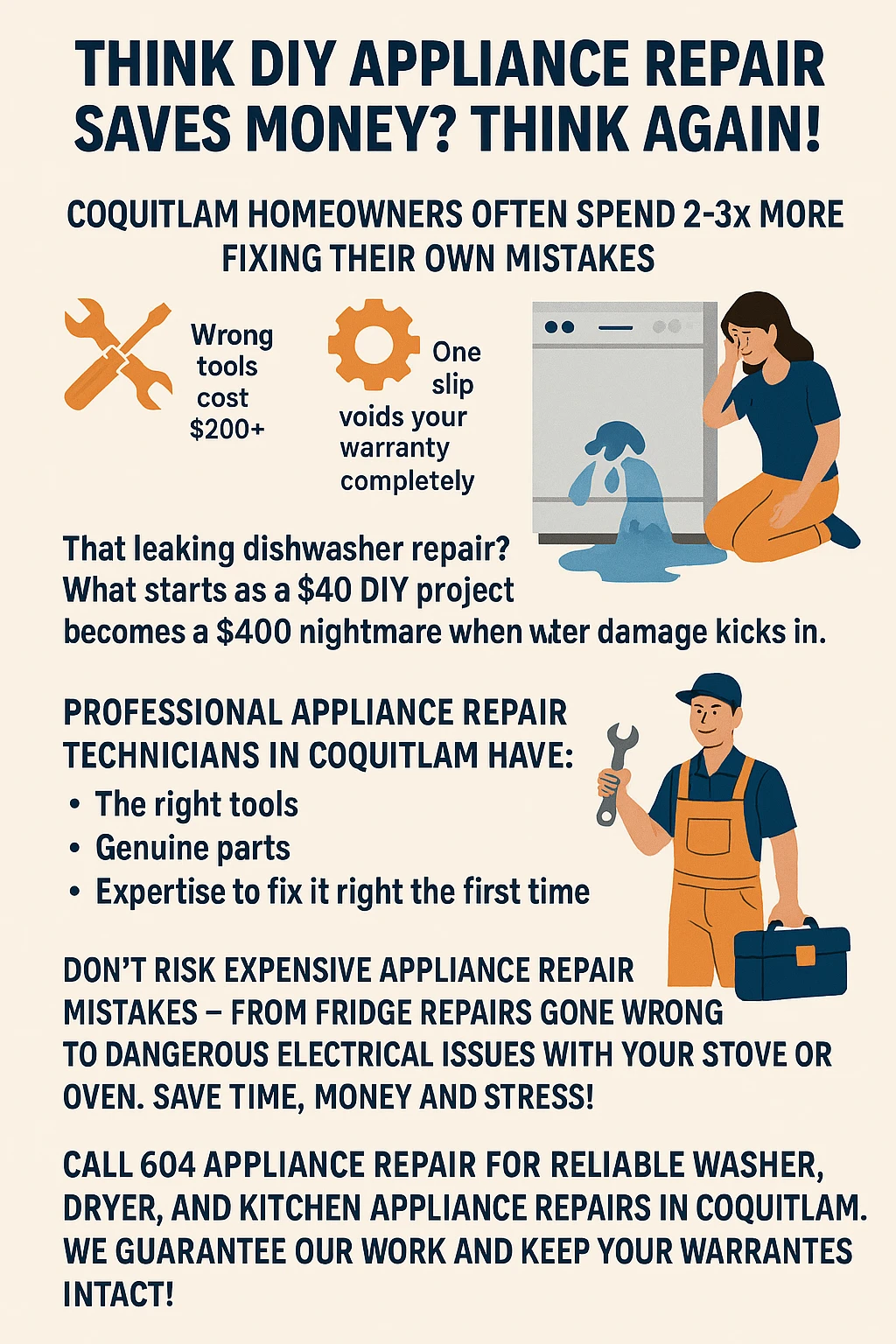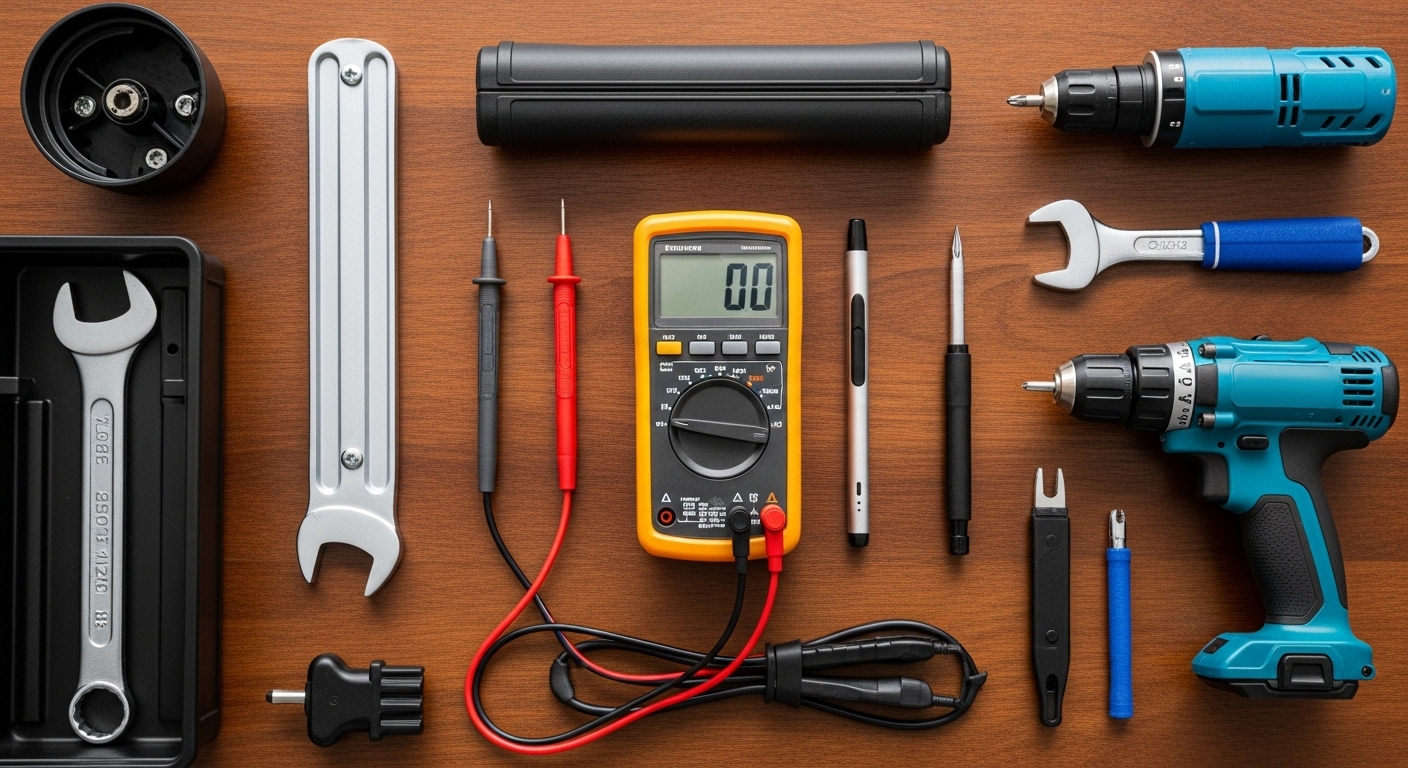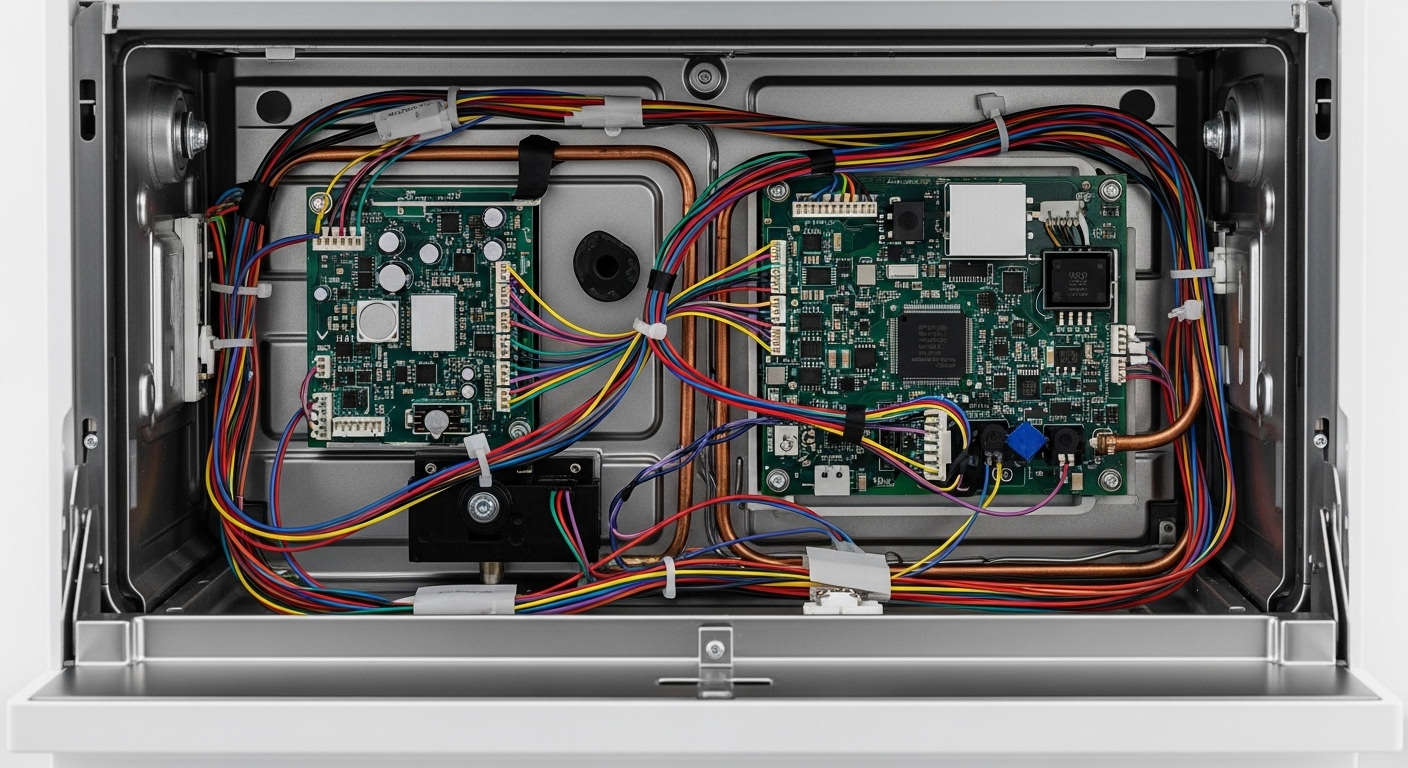The Hidden Costs of DIY Appliance Repairs: Why Coquitlam Homeowners End Up Spending More When Fixing Appliances Themselves
Thinking about tackling that squeaky dryer or leaky dishwasher yourself to save some cash? Before you grab your toolbox and dive into DIY appliance repair, let’s explore why many Coquitlam homeowners end up spending way more money when they attempt to fix appliances themselves rather than calling in the pros.
Picture this: it’s Sunday afternoon, your washing machine starts making that awful grinding noise, and you’re convinced you can save a few hundred bucks by fixing it yourself. After all, how hard could it be? Fast forward three weeks, and you’ve spent $400 on tools, ordered the wrong part twice, accidentally damaged the drum assembly, and now you’re desperately calling a professional repair service anyway. Sound familiar? You’re definitely not alone.

This scenario plays out in homes across Coquitlam every single week, and it’s got homeowners scratching their heads about where their “savings” went. The truth is, DIY appliance repair looks super tempting on paper, but the hidden costs can quickly spiral out of control. From specialized tools you’ll probably never use again to warranty voidance and safety risks, the real price of going the DIY route often exceeds professional service by a significant margin.
What makes this even trickier is that modern appliances aren’t like the simple machines our grandparents owned. Today’s washers, dryers, and dishwashers are packed with electronic components, sensors, and computerized systems that require specialized knowledge to diagnose and repair properly. That innocent-looking error code on your smart refrigerator might seem like a simple fix, but it could actually indicate a complex issue that takes professional training to resolve safely and effectively.
Key Outtakes:
- DIY appliance repairs often cost 2-3 times more than professional service when factoring in tools, mistakes, and warranty voidance
- Misdiagnosis leads to repeat service calls in 25% of cases, potentially doubling repair expenses
- Professional Coquitlam appliance repair services offer transparent pricing and warranties that DIY attempts cannot match
- Safety risks from DIY repairs can result in thousands in property damage and insurance complications
- Tool costs alone can range from $200-1,300 before attempting any actual repairs

The Real Cost of DIY Appliance Repair Tools and Equipment in Coquitlam
Before we dive into the nitty-gritty of repair costs, let’s talk about something most homeowners don’t consider when they decide to go DIY: the tools. Walking into the repair thinking you’ll just grab a screwdriver from your junk drawer is like showing up to a hockey game with figure skates. You’re technically prepared, but you’re missing some pretty essential equipment that can make or break your success.
A basic appliance repair tool set costs anywhere from $200 to $1,300, depending on the quality and completeness of the kit. We’re talking about essentials like a digital multimeter (which can run $15-100), a voltage tester pen ($10-50), a cordless drill with various bits ($40-200), and specialized appliance tools that you literally cannot buy at your neighborhood hardware store. Most homeowners need multiple specialized tools that they’ll probably use exactly once, making the cost-per-use absolutely astronomical.

Here’s where Coquitlam’s unique environmental factors come into play – something that really impacts DIY repair success rates. Our area’s hard water conditions increase repair frequency for dishwashers and washing machines by 20-30% compared to areas with softer water. This means mineral buildup becomes a major culprit in appliance failures, requiring specialized cleaning tools and descaling equipment that most homeowners don’t have on hand. When you attempt a DIY repair without addressing the underlying mineral damage, you’re essentially putting a band-aid on a broken pipe.
Beyond the tools themselves, there’s the parts situation to consider. Appliance parts can cost anywhere from $50 for simple components up to $450 for major pieces like condensers or control boards. Professional technicians get wholesale pricing on these parts, while homeowners pay full retail markups that can be 30-50% higher. Add in the fact that ordering the wrong part (which happens more often than you’d think) results in restocking fees, return shipping costs, and project delays, and those “savings” start evaporating pretty quickly.
The psychological cost factor is something most people don’t account for either. There’s the stress of not knowing if you’re doing it right, the time invested in research and troubleshooting, and the nagging worry that you might be making things worse. When you factor in the opportunity cost of spending your entire weekend wrestling with a broken appliance instead of doing things you actually enjoy, the true expense of DIY repairs becomes even more apparent.
Hidden Costs of Misdiagnosis and Failed DIY Repairs
Moving from tool costs to the really expensive stuff, let’s examine what happens when DIY repairs go sideways – which, unfortunately, happens way more often than most homeowners expect. The statistics around misdiagnosis in appliance repair are pretty eye-opening and help explain why that “simple” fix can quickly turn into a financial nightmare.
Nearly 25% of appliance service visits require follow-up calls due to incorrect initial diagnosis, and that’s with professional technicians who do this for a living. When you’re working with limited experience and basic tools, that percentage jumps significantly higher. Over 54% of repair jobs involve needing additional parts beyond the initial assessment, which means even professionals sometimes get surprised by the complexity of what they’re dealing with. For DIY attempts, this translates to multiple trips to the parts store, mounting frustration, and costs that spiral beyond the original estimate.
Here’s a real-world example that perfectly illustrates how misdiagnosis can double your expenses: you think your refrigerator needs a $400 thermostat replacement based on the symptoms you’re observing. You order the part, spend a weekend installing it, and the problem persists. Turns out the actual issue is a failing compressor that costs $600 plus professional installation. Now you’re out $400 for the unnecessary thermostat, plus the full cost of the actual repair, effectively doubling what you would have paid for proper professional diagnosis from the start.
The cascading damage factor is something that keeps professional repair technicians busy and homeowneres stressed. Incorrect repairs don’t just fail to fix the original problem – they often damage additional components, turning a simple $100 fix into a $500+ major repair situation. This is especially common with complex appliances like washing machines, where reassembly errors can cause mechanical damage to parts that were working perfectly fine before you started tinkering.

Each professional service call costs $50-200 plus $50-150 per hour labor when DIY attempts fail, and failed DIY attempts often require complete disassembly and reassembly by professionals who now have to undo your work before they can even begin the actual repair. The average appliance repair job costs around $130 CAD in Coquitlam when done right the first time, but when you factor in the additional labor to correct DIY mistakes, costs can easily double or triple.
There’s also the time factor to consider seriously. Professional repairs typically take 1-2 hours for most common issues. DIY repairs take 3-5 times longer for the same problems, assuming you actually manage to complete them successfully. When you calculate the value of your time, plus the extended period your appliance is out of commission, the hidden costs become substantial. Your family can’t do laundry for two weeks while you figure out washing machine repair, but professional service gets you back up and running the same day.
How DIY Repairs Void Warranties and Create Long-Term Expenses
Now let’s talk about one of the most expensive mistakes homeowners make when attempting DIY appliance repairs – something that can cost thousands of dollars down the road and doesn’t become apparent until it’s too late. Understanding warranty implications is crucial because this single factor can make DIY repairs the most expensive option by far, even when the actual repair work goes perfectly.
Many appliance warranties explicitly state that DIY repairs void coverage entirely, regardless of whether your repair attempt was successful or not. This means that even if you successfully fix a broken thermostat on your washing machine, you’ve just eliminated any future warranty protection for unrelated issues like motor failures or control board problems. Appliances typically come with multi-year warranties that can save thousands in future repairs, and losing this coverage for a
